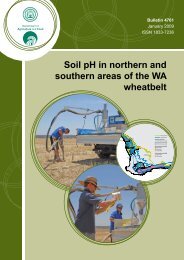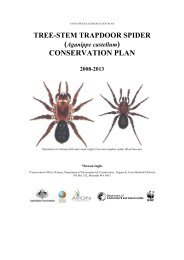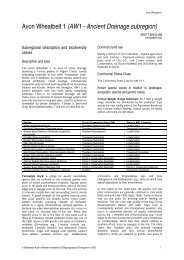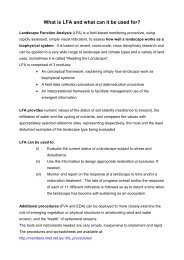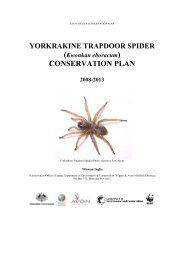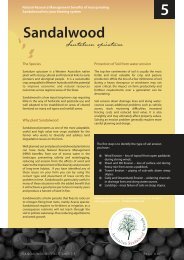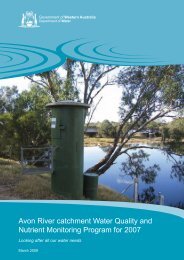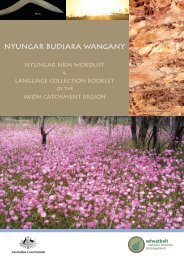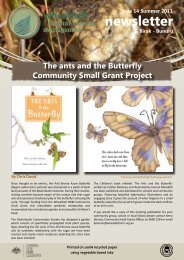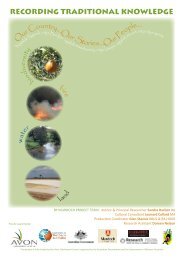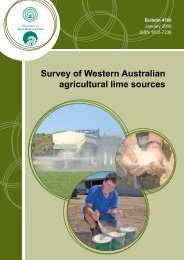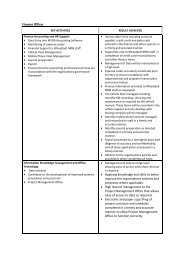Kokerbin Nature Reserve Desktop Fauna ... - Wheatbelt NRM
Kokerbin Nature Reserve Desktop Fauna ... - Wheatbelt NRM
Kokerbin Nature Reserve Desktop Fauna ... - Wheatbelt NRM
Create successful ePaper yourself
Turn your PDF publications into a flip-book with our unique Google optimized e-Paper software.
<strong>Kokerbin</strong> <strong>Nature</strong> <strong>Reserve</strong><br />
<strong>Desktop</strong> <strong>Fauna</strong> Assessment<br />
with steep cliffs, ledges, gorges, terraces, caves and large rock piles, often occurring<br />
near waterholes (Creese, 2007). Competition for food resources with introduced and<br />
abundant native herbivores (eg. Feral Goat and the Euro), predation from introduced<br />
and native predators (eg. Feral Cat, Fox and Wedge-tailed Eagle) and habitat<br />
degradation (through grazing, fire and the Feral Goat) have been implicated as<br />
threatening processes limiting rock wallaby populations (Species Bank, 2009).<br />
The Black-flanked Rock-wallaby was formerly widespread across the <strong>Wheatbelt</strong><br />
region occurring on many rocky hills and granite outcrops. The Black-flanked Rockwallaby<br />
is known from <strong>Kokerbin</strong> <strong>Nature</strong> <strong>Reserve</strong> inhabiting rock crevices and caves<br />
at <strong>Kokerbin</strong> Rock following its self-reintroduction from neighbouring populations<br />
after having recovered in numbers from fox baiting.<br />
Tammar Wallaby (Macropus eugenii) PRIORITY 5<br />
The Tammar Wallaby is listed as Priority 5 by DEC. This species was formerly<br />
distributed across much of south-western Australia but now occurs in a few scattered<br />
populations including Dryandra and near Pingelly (DEC, 2009). The Tammar<br />
Wallaby inhabits coastal scrub, heath, forest, mallee and woodland. This species has<br />
been previously recorded north of Yoting and may persist in the region.<br />
Quenda (Southern Brown Bandicoot) Isoodon obesulus PRIORITY 5<br />
The Quenda is listed as Priority 5 by DEC and has declined over much of its range<br />
including on the Swan Coastal Plain. The Southern Brown Bandicoot occurs in the<br />
south-west of Western Australia north to Yanchep and Gingin, south to Albany and<br />
east to Esperance. This species previously occurred north to Moore River and east<br />
throughout the <strong>Wheatbelt</strong> but like many mammals in the region has undergone a large<br />
range reduction (Maxwell et al. 1996). On the Swan Coastal Plain it is patchily<br />
distributed, as a result of land clearance, habitat degradation and feral predators, and<br />
often occurs in small and fragmented populations (DEC, 2008). It is commonly<br />
associated with dense, low vegetation. This species is considered locally extinct in the<br />
<strong>Kokerbin</strong> region.<br />
Western Brush Wallaby (Macropus irma) PRIORITY 4<br />
The Western Brush Wallaby is listed as Priority 4 by DEC. This species occurs in<br />
south-western Australia, from Kalbarri to Cape Arid. The Western Brush Wallaby<br />
formerly occurred over a much larger area however has suffered a large range<br />
reduction and fragmentation of populations due to clearing for agriculture and<br />
predation by introduced predators (DEC, 2008). The optimum habitat for the Western<br />
Brush Wallaby is open forest or woodland, in which it favours open, seasonally wet<br />
flats with low grasses and open, scrubby thickets (Strahan, 1995), and areas of dense<br />
vegetation. It is also found in mallee and heathland (DEC, 2008). The Brush Wallaby<br />
has been recorded in the Beverley area and occurs in reasonable numbers throughout<br />
intact bushland west of Beverley (J. Turpin. Pers. obs.).<br />
Greater Long-eared Bat (Central Form, Nyctophilus timoriensis) PRIORITY 4<br />
34



